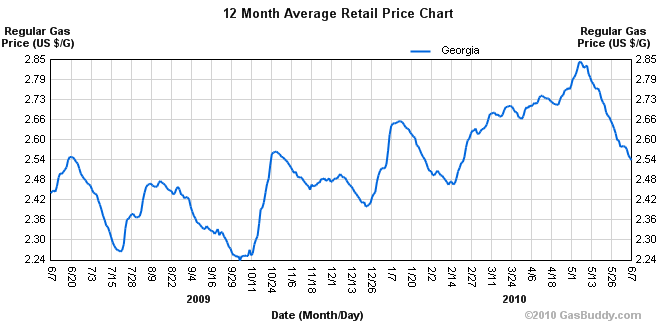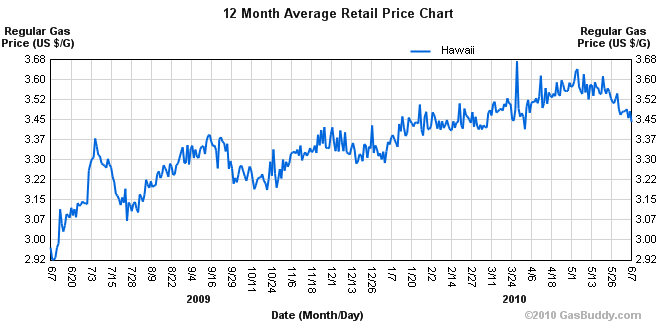

Comparison
The prices in the graphs are given in Dollars per Gallon (US$/ Gallon). The graphs show the trend of the cost of gasoline over the past year (from the 7th of June 2009 to the 7th of June 2010) for both Georgia and Hawaii States. The vertical axis to both the left and right depicts an increase of $ 0.08 in the price of gasoline while the horizontal axis captures the time in terms of every additional five days.
It is evident from the first graph that the prices of gasoline in Georgia have been irregularly oscillating over a wider range of prices at least every two months. Take for example the price dip from $ 2.48/G on the 20th of June in 2009 to $ 2.27/G in the subsequent month. On the other hand in Hawaii, over the same period, there is an almost smooth rise in the prices from $ 2.92/G to a peak of $ 3.37/G on the 5th of July. This means that the prices in Georgia were highly unpredictable unlike in Hawaii.
From the beginning of October 2009 to the 24th, the price rises from $ 2.24/G to $ 2.57/G in Georgia while in Hawaii, over the same period, the prices are smoothly fluctuating almost daily with no significant gain or fall. This means that consumers in Georgia had to cater for the sharp increase in price while their counterparts enjoyed relatively stable prices.
In Georgia, the highest price of $ 2.85/G was recorded on the 7th of May this year while in Hawaii high of $ 3.68/G was recorded on the 25th of March of this year. This is a difference of about $ 1.0/G. A low of $ 2.24/G was recorded on the 5th of October last year in Georgia while in Hawaii a low of $ 2.92/G was recorded on the 7th of June last year. The difference here is about $ 0.68/G. The disparities in the differences can be attributed to many factors affecting the demand and supply of gasoline as well as the international prices for crude oil.
The overall price change in Georgia over the last year is an increase of about $ 0.1/G and on the other hand, in Hawaii, the price increased by close to $ 0.53/G. If the prices in Hawaii over the considered period are plotted using the line of best fit then it will show a smooth rise. It follows the trend of a learning curve. But for Georgia, a line of best fit will be intermittent over the period nevertheless rising in the end.
It can also be seen that the prices of gasoline in Georgia are relatively lower. The highest price in Georgia for the period is $ 2.85/G while the lowest in Hawaii is $ 2.92/G. This means that the least price paid by a consumer in Hawaii is way above the highest price paid by one in Georgia.
Conclusion
In conclusion, therefore, it is noteworthy to argue that the prices of gasoline in Hawaii over the past year have been high compared to those charged by retailers in Georgia. However, the prices charged in Georgia have been steadily rising over the twelve months while in Hawaii, the prices have been swinging up and down during a similar period (McConnell & Brue, 2008).
References
- Georgia gas prices. (n.d.). Web.
- Hawaii gas prices. (n.d.). Web.
- McConnell, C.R. & Brue, S.L. (2008). Microeconomics. 18th ed. McGraw-Hill Higher Education